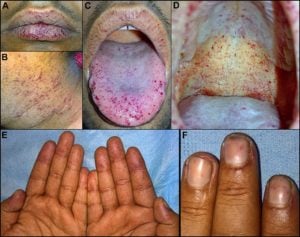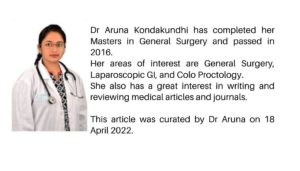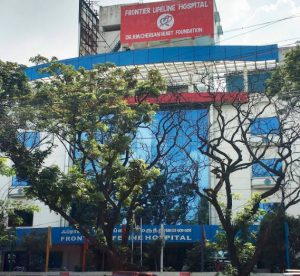Hereditary Hemorrhagic Telangiectasia (HHT)
What is Hereditary Hemorrhagic Telangiectasia (HHT)? Telangiectasiaoccurs when abnormalities such as arteriovenous malformations are found in vessels close to the skin’s surface and can be seen as red markings. Hereditary Hemorrhagic Telangiectasia (HHT) is a rare inherited disorder characterized by multiple abnormalities in blood vessels, causing abnormal connections to form known as “arteriovenous malformations. ” […] Read More
Top Doctors For Hereditary Hemorrhagic Telangiectasia (HHT) Treatments
Top Hospitals For Hereditary Hemorrhagic Telangiectasia (HHT) Treatments
Hereditary Hemorrhagic Telangiectasia (HHT)
What is Hereditary Hemorrhagic Telangiectasia (HHT)?
Telangiectasiaoccurs when abnormalities such as arteriovenous malformations are found in vessels close to the skin’s surface and can be seen as red markings. Hereditary Hemorrhagic Telangiectasia (HHT) is a rare inherited disorder characterized by multiple abnormalities in blood vessels, causing abnormal connections to form known as “arteriovenous malformations. ” These malformations could be found mainly in the nose, lungs, liver, brain, sometimes the urinary tract, gastrointestinal (GI) tract, conjunctiva, trunk, arms, and fingers. This condition is also called “Osler Weber Rendu Disease (OWRD),” a genetic disorder inherited from parents. Picture Courtesy: Semanticscholar
In HHT, blood vessels are not formed properly, mostly without capillaries, which are tiny blood vessels found between arteries and veins, in which blood flows from arteries to veins. Without the buffer the capillaries offer, blood flow becomes high, giving extra pressure to the walls of the veins, resulting in compression and irritation of adjacent tissues, hence resulting in hemorrhage.
One of the major symptoms is nosebleeding, also called Epistaxis, which could be sudden and mostly unprovoked. It could even occur daily, resulting in low iron concentration in the body and anemia, which may require a blood transfusion.
HHT ranges from mild to severe, but effective treatments can help manage the situation if diagnosed early, but there is no cure. It affects both males and females, young and old. The symptoms of HHT may start or be delayed until the later part of life.
Hereditary hemorrhagic telangiectasia is widely distributed, occurring in many ethnic groups worldwide. It affects people in the range of 1 in 5,000 and 1 in 10,000 people.
Source: www.medlineplus.gov
Picture Courtesy: Semanticscholar
In HHT, blood vessels are not formed properly, mostly without capillaries, which are tiny blood vessels found between arteries and veins, in which blood flows from arteries to veins. Without the buffer the capillaries offer, blood flow becomes high, giving extra pressure to the walls of the veins, resulting in compression and irritation of adjacent tissues, hence resulting in hemorrhage.
One of the major symptoms is nosebleeding, also called Epistaxis, which could be sudden and mostly unprovoked. It could even occur daily, resulting in low iron concentration in the body and anemia, which may require a blood transfusion.
HHT ranges from mild to severe, but effective treatments can help manage the situation if diagnosed early, but there is no cure. It affects both males and females, young and old. The symptoms of HHT may start or be delayed until the later part of life.
Hereditary hemorrhagic telangiectasia is widely distributed, occurring in many ethnic groups worldwide. It affects people in the range of 1 in 5,000 and 1 in 10,000 people.
Source: www.medlineplus.gov
Types of HHT
They are classified according to their genetic cause. They include:- Hereditary hemorrhagic telangiectasia type I
- Hereditary hemorrhagic telangiectasia type II
- Hereditary hemorrhagic telangiectasia type III
- Hereditary hemorrhagic telangiectasia- Juvenile polyposis overlap syndrome (JPHT) [1]
Diagnosed with HHT
HHT can be detected using:- Genetic testing is used to detect gene mutation in approximately ¾ of families with a history of HHT.
- Tracing family medical history.
- The doctor will carry out a clinical examination and check certain criteria, such as recurrent nosebleeds, multiple telangiectases in specific locations, the presence of Arteriovenous malformations(AVMs), and a family history of HHT.
- Blood tests such as complete blood count, coagulation profile findings such as Prothrombin time (PT), aPTT (activated Partial Thromboplastin Time), and elevated levels may influence thrombotic risk in HHT.
- Urinalysis, Liver function test.
- ABG (Arterial Blood Gas) assessment.
- Endoscopy and biopsy study and histological findings.
- Imaging scans include computerized tomography, MRI scan, Angiography, ultrasonography, contrast echocardiography imaging, bubble study, etc.
Treatment of HHT
Since this is a rare condition, treatment of HHT includes:-
- Medication, which includes drugs that help reduce the bleeding, such as anti-estrogen drugs, and aminocaproic acid, blocks the blood vessel growth like bevacizumab (Avastin) administered intravenously and reduces the disintegration of clots, e.g., Tranexamic acid (Cyklokapron, Lysteda).
- Sometimes medication for the anemia is also given. The doctor could give it intravenously or through a blood transfusion or an iron infusion.
- Bleeding from the nose is one of the primary signs of HHT, sometimes occurring daily, leading to anemia. Hence, steps need to be taken to reduce the frequency and severity of the bleeding of the nose. Such as :
-
-
- Ablation
-
-
-
- Skin Grafting
-
-
- Surgery
-
-
- The nose, as nose bleeding. This can be treated using surgery to close the nostrils if nothing works and, in extreme cases, by connecting the flaps between the nose’s skin.
- Another site includes the lungs, brain, and liver. Arteriovenous malformations that are found here can be treated using:
- Embolization involves inserting a long, slender tube through the blood vessels to the affected place. A plug or a metal coil is placed to block blood from entering the Arteriovenous Malformations, which shrinks and heals.
-
-
-
- In some extreme cases, the surgeon can surgically remove arteriovenous malformations. This could serve as the best option in extreme cases in the lungs, brain, or liver, although there is an increase in surgical risks.
- Stereotactic radiotherapy could be employed. The intravenous malformations are placed at the intersection where beams of radiation from different directions intersect, hence destroying it.
-
-
-
- A liver transplant, although rare, can be used as a treatment procedure for arteriovenous malformations occurring in the liver.
-
Complications of HHT are:
The complications of HHT depend on the organ they affect and the treatment procedure that has to be employed. It could vary widely according to individual differences, even in the same family. A few of the complications are listed below:-
-
- Nose bleeding
- Pulmonary AVMs (arteriovenous malformation)
- Cerebral AVMs
- Gastrointestinal bleeding
- Hepatic AVMs [2].
- Brain abscess
- Hemorrhagic or ischemic stroke
- High-output congestive heart failure
- Portal hypertension with esophageal varices [3]
-
 Picture courtesy: amjmed
Picture courtesy: amjmed
Symptoms
Symptoms of HHT
The symptoms of HHT include:
- Nosebleeds or Epistaxis could start in infancy and occurs sometimes daily.
- Telangiectasia or lacy red vessels or tiny red spots, especially on the lips, face, fingertips, tongue, and sometimes inside the surfaces of the mouth.
- Iron deficiency anemia.
- Shortness of breath.
- Headaches.
- Seizures due to abnormal artery-vein connections within the brain.
- Bleeding in the gastrointestinal tract due to abnormal blood vessels lining the digestive tract.
Causes
Causes of HHT
Since HHT is a hereditary condition, it can be caused by genetic predisposition and abnormality, resulting from alteration of the gene, mutated external icon, and one normal gene.
A recent study has shown that a minimum of five different genes could cause HHT, of which 3 are known. Children that have HHT stand a 50% chance of having the altered gene from his or her parent. There are also other cases where the mutation could be acquired due to environmental factors.
FAQ
What is hemorrhage?
Hemorrhage occurs when the skin is prone to bleed, usually from the nose or gastrointestinal tract.
What is Telangiectasia?
Telangiectasia is a malformed small blood vessel appearing to tangle, mostly found on the skin and nose. Arteriovenous Malformations (AVMs) are larger malformed blood vessels than telangiectasia.
Should I tell my family if I get a positive result for the HHT test?
Definitely.
This will help the family members screen and undergo a few tests for HHT, check for the family mutation, and screen for vascular malformations, especially in the brain, lungs, and liver.
If I have HHT, what are the chances my children will have it?
Since HHT is an autosomal dominant disease and hereditary, there is a 50% probability of transferring the mutated gene to your child.
Do people with HHT have a normal life span?
People affected with HHT can still lead a normal life, although a few adjustments will have to be made, such as:
Avoid certain medications that increase the risk of bleeding.
Stop taking anything that tends to trigger the nosebleed and avoid certain foods such as red wine, blueberries, spicy food, and dark chocolate.
Also, try to keep the nose moist by applying saline sprays and moisturizing ointments.
Is hereditary hemorrhagic telangiectasia dominant or recessive disorder?
Hereditary hemorrhagic telangiectasia is considered to be a dominant disorder [4].
Is hereditary hemorrhagic telangiectasia dangerous?
HHT is a disorder that results in multiple abnormalities in blood vessels. HHT can be life-threatening if left untreated. Early diagnosis and early treatment help in recovering the patient.
References
- https://emedicine.medscape.com/article/2048472-overview#a4https://www.uclahealth.org/radiology/hht/specific-complications
- https://emedicine.medscape.com/article/2048472-clinical#b3
- https://www.ncbi.nlm.nih.gov/books/NBK1351/










































